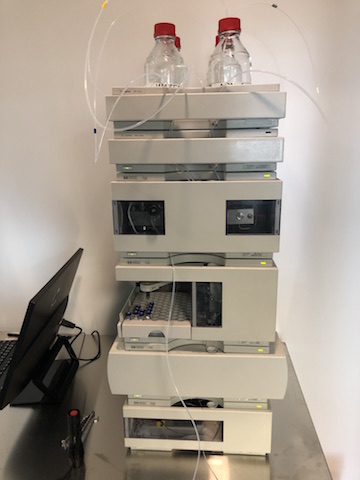Knowledge is all important. The more information one has, the better the decision-making process. This holds true for any scientific inquiry, and certainly applies to hemp farming and processing. Thus, we gather information. One method for acquiring information is via the use of analytical instrumentation which is critical to our testing philosophy. Our preferred method for analysis is high performance liquid chromatography (HPLC) which accurate to within 1%.
HPLC, however, is only as accurate as the method used, operator competence, and the sampling methods employed. While we take great pride in our methods and comptency, the sampling of the items to be tested is challenging. Let’s expand on that thought.
When a pharmaceutical company assays its ingredients, the chemists are sampling a nearly homogeneous bottle of white powder. Shake the bottle, and one is fairly confident that the sample pulled is representative. Two samples from the same bottle should analyze as identical. (If not, then you have problems…).
We don’t work with free-flowing homogeneous powders. We test plant material, extracted oils, and diluted products. Obtaining a representative sample of these materials is much more difficult.
Hemp Testing
Consider the analysis of hemp flower. First, you must define what a “flower” is. Does it include the adjacent fan leaves? Stems? What do you do when a sample has flower, leaves, and stems? These seemingly silly issues can change the assay results by a substantial amount. Plus, no two flowers are the same. They are the opposite of homogeneous.
We have tested flower from the same plant, and have seen variance of as much as 40% between flowers. Where the flower grows on the plant is one variable: lower buds, in general, have lower cannabinoid content than flowers close to the top of the plant. The stem and leaf issues cause more problems.
What to do? Testing Philosophy for Hemp
Well, the first thought may be to simply grind the material, so that it becomes “homogeneous.” This is a mistake: All the cannabinoids are contained on the outside of the material in the trichomes: Grinding can strip the plant of its trichomes affecting assay results drastically. In essence, one can leave a bunch of cannabinoids in the grinder. We do not grind our plant samples. The whole bud is soaked to gently extract the active ingredients.
Our “whole bud soak” method was presented at the American Chemical Society’s annual meeting in 2018. The method information is freely available to the public: contact us if interested.
The next issue is how do you determine the titer of a farmer’s crop of hundreds of pounds of biomass. How can you be sure your pulling a representative sample? What if the bag you pulled to sample consists of lots of leaves and stems, or comes from the bottom of the plant?
The only way to deal with a situation like that is to pull multiple samples, run the assays, and average the results. How many samples? That depends on how much time (money) you have. The more the better: if you have 20 containers, and take five samples from each, that’s 100 assays. That’s well and good, but 100 assays are time consuming and expensive. And you still can’t be sure the five samples pulled from each bag are representative of that bag.
The only surefire way to get an accurate titer is to assay the whole batch, and the only way to do that is to extract the whole batch and assay the extract. A rather laborious and impractical method, but is the only true measure of the cannabinoid content of the biomass.
The bottom line: Biomass assays give an approximation of the CBD and THC content. Read the assay results with care. The numbers provided could have very large error bars if limited sampling has occurred. If you have any questions on our testing philosophy feel free to reach out!
